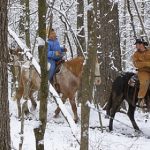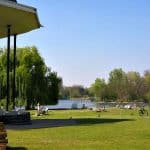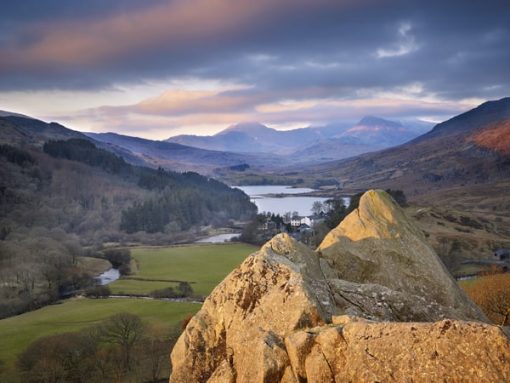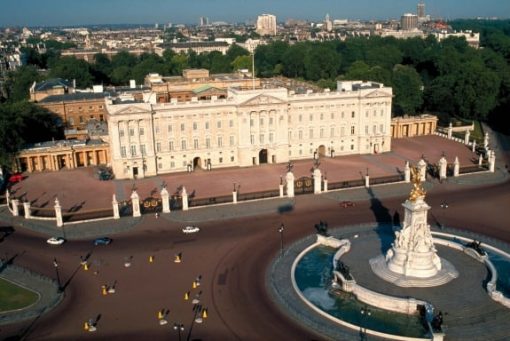Fall brings a glorious change of color to Scottish highlands, gardens, and woodlands. Here are some suggestions of the most beautiful places to go to see nature’s colorful display.
Scotland’s landscape is one of golds and browns as the trees change color and shed their leaves in readiness for winter. The countryside is a great place for a road trip and it is full of glorious views of autumn color – and there are many gardens where non-native trees add a splash of brightness to nature’s palette.
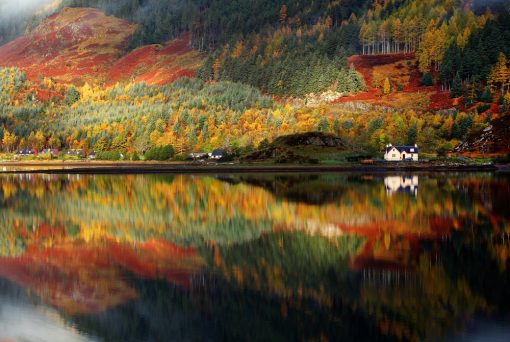
Here are some suggestions of the top places to visit in Scotland during the fall.
Table of Contents
Isle Of Skye
Mist-shrouded moors and mountains, otters swimming in secluded havens, and a Prince fleeing through the heather all contribute to the magic of Skye. The landscape of Skye has scarcely changed since the legendary piper, Donald MacCrimmon, foreseeing terrible slaughter following the Battle of Culloden, composed this lament.
‘Round Cuillin’s peak the mist is sailin’
The banshee croons her note of wailin’
But my blue een wi’ sorrow are streamin’
For him that will never return – MacCrimmon’
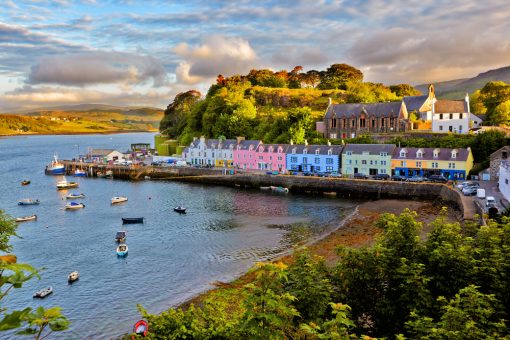
Skye is the largest island in Scotland. It’s steeped in history where you can walk along the best beaches with white sands or over lonely moorland in the footsteps of Bonnie Prince Charlie. There is still plenty of evidence of the Highland hospitality which sustained the footsore prince on his wanderings.
From Kyle of Lochalsh cross the Skye Bridge and tour the narrow, winding, single-track roads along the coastline to Portree. Or cross the moor through small townships that amount to no more than a handful of cottages. Don’t expect great weather, but when the sun shines, Skye is glorious with clear blue skies creating a perfect backdrop for the stark, jagged peaks of the Cuillins.
Even when it’s raining, the atmosphere will capture you – when the stark lines of the Cuillins are softened by swirling clouds, half hidden by fine drizzle, or obliterated by sheeting rain. Curlews call out on the moor and in early summer the unique song of the cuckoo reverberates on every side. From the coast road, turn left at Sligachan, through Glen Drynoch to Dunvegan. Look for signs for the Talisker Distillery near the end of the Glen and take the short detour to the shores of Loch Harport. You can tour the distillery here and try a small dram of Skye’s Uisge Beatha, the Water of Life.
Returning to the main road continue to Dunvegan, a great place to view a classic west coast sunset. Then continue, via Uig, round the strange Trotternish Peninsula, where you’ll find the Old Man of Storr, a column of rock precariously balanced, and looking about to topple at any moment.
Nearby the weird rock formations of the Quiraing evoke images of giants and legends. Heading south you pass through the main settlement of Portree, with its colorful houses and elegant town square. The main road runs south back to tiny Kyleakin, its white cottages clustered around the small harbor with its fishing boats and visiting yachts.
From the Bright Water Visitor Centre on the harborside, you can visit Eilean Bhan, the White Island, the last home of Gavin Maxwell author of Ring of Bright Water. His long sitting room in the former lighthouse keeper’s cottage has been restored as a museum and there is a nature trail and the grave of Maxwell’s Otter Teko.
Crarae Gardens
Crarae Gardens lies on Scotland’s west coast near the village of Inverary, where the warming effects of the Gulf Stream promote the growth of many lush and exotic plants. It’s a perfect place for nature lovers.
A woodland garden covering an area of 100 acres, it clings to a steep hill and in autumn is dominated by native trees such as rowan and birch, as well as by spectacular maples and many Himalayan species.
In autumn Crarae attracts red squirrels, which come to feed on the many berries and seeds produced in the woodlands. The property of the National Trust for Scotland, the garden is open all year from 9 am until sunset: the on-site visitor center is open in summer only (April-October) from Thursday to Monday.
Mellerstain
Mellerstain House, near Duns in the Scottish Borders, is one of the most popular attractions in Scotland. It is best known for its stately home, but in autumn the grounds come into their own. Though the gardens themselves are relatively small, the surrounding parkland, with its huge lawns backed by magnificent trees, turns to a dramatic backdrop in shades of golden, yellow, and brown.
The gardens are open from 11 am-5 pm, but opening times vary according to the seasons (check for details) and both houses and gardens are closed between November and May (but open for the Easter weekend).
Royal Botanic Garden, Edinburgh
Edinburgh’s Royal Botanic Garden stands in the north of the beautiful city and is predominantly an arboretum, with a huge variety of trees standing in a large and hilly park. As well as wonderful views of the Edinburgh castle skyline, the Botanics in autumn offers splendid color from trees and shrubs and is a popular place for the silver city’s kids – of all ages – to kick around in the thick layers of leaves and look for fungi in the cryptogamic garden.
Admission to the gardens is free (although there is a charge to visit the Glasshouse exhibit) and they are open from 10 am daily (closing times vary with the season). The RBG has recently opened a new visitor facility with a shop, café, and exhibitions. The woodland outstations of the gardens, at Benmore in Argyll and Dawyck in the Borders, are also good places for autumn visitors.
Scotland’s Forests
Of course, there are many places of natural beauty to see without visiting a formal, or even a woodland, garden. Large areas of Scotland are forested, either naturally or as a result of deliberate planting, and there is an excellent right to public access to the countryside. Organizations such as the Forestry Commission, National Trust for Scotland, and some estates provide visitor facilities in some areas.
Some suggested locations for a drive or a short walk include:
- Scott’s View, near Abbotsford in the Borders
- The Queen’s View on Loch Tay
- Wooded highland glens such as Glen Affric and Glen Garry
- Highland Perthshire, including Dollar Glen, the Pass of Killiecrankie, and the Hermitage at Dunblane
- The Caledonian forest, in particular around Aviemore and Loch Morlich.
Any list of suggested places will leave out someone’s favorite so a personal recommendation is useful. Try asking locally.
Strange Places Worth Visiting In Scotland
Mainland Scotland boasts a host of unusual places for inquisitive tourists to visit. From an Egyptian lighthouse to an underground nuclear bunker, there are strange locations to be investigated all over the country.
The Electric Brae
For the unknowing, it is easy to drive over this stretch of road, between Dunure and Croy Bay, on the A719, without noticing anything remarkable. It is only when visitors park their cars on the road and release the brake that the optical illusion becomes apparent. Due to the profile of the surrounding land, it appears that vehicles roll uphill.
Although it is best known as the Electric Brae, many locals refer to it as Croy Brae. The word ‘brae’ is a Scottish term for the hill.
The Secret Bunker
The entrance to this Cold War stronghold is located under a very normal-looking farmhouse, just off the B940 near Anstruther. Visitors descend deep underground into a two-story bunker covering 24,000 square feet.
Built as a center from which Scotland could be governed in the event of nuclear war, it is now a major tourist attraction. History buffs will love it.
Pineapple House
Built in 1761, this summer house is a remarkable structure with a roof constructed to resemble a giant pineapple.
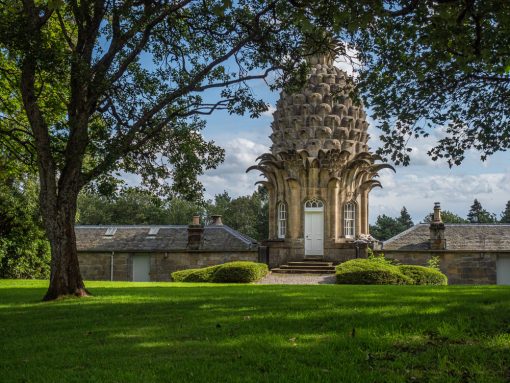
Now restored to its former glory, the house is also available as a vacation home rental. It is situated in Dunmore, on the A905.
Fernie Castle Tree House
For anyone who’s ever wondered what it would be like to be a member of the Swiss Family Robinson, Fernie Castle offers an ideal place to stay.
The tree house accommodation offers an alternative to a traditional hotel room. Featuring three balconies, a swing, and all the modern necessities it is a unique experience. Such exclusivity doesn’t come cheap, however, and visitors should expect prices starts at about from $600 per night.
Ardnamurchan Lighthouse
The Scottish, and in particular the Stevenson family, were renowned for their lighthouses, with many examples of their work around the world. Built by Robert Louis Stevenson’s uncle, Alan, Ardnamurchan Lighthouse is unique for its construction in an Egyptian style.
Completed in 1849, it was the inspiration for Alice Thompson’s ghost story, Pharos. This local story claims that, in the nineteenth century, all three lightkeepers vanished and were never seen again.
Strachur Swamp Soccer
The village of Strachur would be a fairly unremarkable place were it not for the swamp soccer tournament held there each June.
The sport originated in Finland during the nineties and consists of a football pitch doused with water and mud, making it a very messy affair. It now attracts teams from around the world.
Castles
Nothing evokes romance and fairy tales more than a Scottish Castle. Here are some of the most popular castles in the Scottish highlands.
Caerlaverock Castle
Caerlaverock Castle is considered one of the best surviving medieval castles in Britain. The great medieval fortress comes fully equipped with a moat, imposing battlements, and a twin towered gatehouse. Situated in the southwest of mainland Scotland, Caerlaverock has a turbulent and interesting history due to its close proximity to the border with England, and it played an important role in the defense of the realm. Dating back to the 13th century, this castle has a wonderfully unique triangle shape.
Cawdor Castle
Often referred to as the most romantic castle in the highlands, this splendid private fortress sits next to the River Nairn and is surrounded by beautiful gardens, rolling lawns, and a maze. Built by the Thanes of Cawdor in the 14th century, Cawdor’s central five-story tower is considered one of Scotland’s finest medieval structures. The castle is famous for its connection to Shakespeare’s Macbeth who was promised by the witches the Thanedom of Cawdor. While a lovely legend, Macbeth lived two centuries before Cawdor Castle was even built.
Culzean Castle
Culzean is one of the finest homes built in Scotland by celebrated architect Robert Adam. This beautifully elegant 18th-century castle sits on the edge of a rocky promontory with stunning views over Culzean Bay and the Firth of Clyde. Georgian in style, it is set on spacious grounds, with approximately 600 acres of formal gardens, coastline, and woodlands.
Drumlanrig Castle
Located in South West Scotland overlooking the breathtaking Nith Valley, Drumlanrig Castle represents one of the first and most important Renaissance buildings in Scotland. Built by the first Duke of Queensberry in the 17th century, on the site of an ancient Douglas stronghold, the castle is constructed from distinctive pink sandstone. Surrounded by impressive gardens extending 40 acres, Drumlanrig houses famous artwork and the antiquities of numerous illustrious families.
Dunnottar Castle
It doesn’t get more picturesque than this. Dunnottar is beautifully situated on a rocky promontory whose sheer cliffs drop off into the North Sea. A ruined medieval fortress, Dunnottar was the last Scottish castle to fall to Cromwell’s troops in the Civil War. The site has been inhabited since Pictish times, but surviving buildings mostly date from the 15th and 16th centuries.
The access path to the castle is both steep and about a 30-minute walk, so it is not suitable for everyone.
Dunvegan Castle
Dunvegan Castle is built on a rocky outcrop overlooking Loch Dunvegan on the beautiful Isle of Skye. The castle has been the ancestral home of the Chiefs of the Clan MacLeod for nearly eight centuries, making it the oldest continuously inhabited castle in Scotland. Dunvegan’s rich history includes architectural highlights spanning ten building eras.
Edinburgh Castle
No other city in Europe is as dominated by a castle as Edinburgh. Built on an extinct volcano with views of the city, Edinburgh Castle has witnessed some of the most defining moments in Scottish history. A popular tourist attraction, it is worth the time to visit.
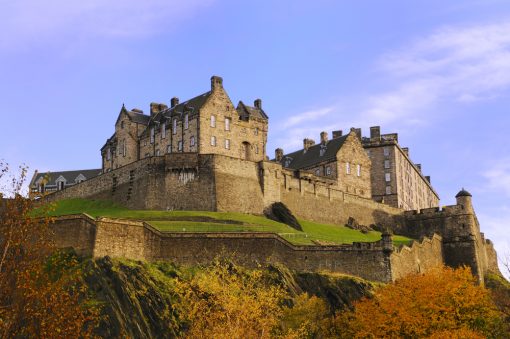
Once a palace, once a parliament, and an ancient fortress, it has inhabited this rocky site since the Iron Age. The earliest parts of the present castle date to the early 16th century and include St. Margaret’s Chapel, the Royal Apartments, and the Great Hall. The castle houses the Stone of Destiny (the coronation seat of Scottish Kings) and the oldest crown Jewels in the British Isles.
The Royal Mile, which runs through Edinburgh’s Old Town, connects the castle with the Palace of Holyroodhouse, another of the city’s top attractions. The city of Edinburgh is a UNESCO World Heritage site, one of six in Scotland.
Eilean Donan Castle
Eilean Donan is the most picturesque of the Highland castles, certainly one of the most photographed. Magnificently situated on a rocky island at the junction of three separate sea lochs, this spot is incomparable and the view is breathtaking. Built as a defense against the Danes in the 13th century, the castle was passed to the Mckenzies and destroyed during the Jacobite risings, before being restored to its former glory in the early 20th century.
Glamis Castle
Glamis Castle has been a royal residence since 1372. Princess Margaret was born here and the Queen Mother grew up at Glamis. The tower at Glamis dates from the 14th century and forms the heart of the present structure, which has evolved over the years into a luxurious dwelling, containing some wonderful art and furniture.
Glamis is not only said to be the legendary setting of Shakespeare’s play Macbeth but one of Scotland’s most haunted castles. One supposed ghost is Lady Glamis who was burnt as a witch by James V in order to annex her castle.
Stirling Castle
Like Edinburgh, Stirling Castle is built on the summit of an extinct volcano that dominates both the town and surrounding countryside, providing a look at the historic architecture and stunning and spectacular views over two of Scotland’s most famous battlefields, Bannockburn and Stirling Bridge. The setting for many events in Scottish history, Stirling has played the role of the regimental garrison, royal stronghold, and palace of pleasures. The bulk of the existing castle dates from the 15th to 18th centuries.
Stirling Castle has been a film site for Game of Thrones and Outlander, making it a perfect destination for television buffs.
Hill Walking
Hill-walking is a hugely popular activity, pursued by a people from all over the world. The mountainous, dramatic landscapes and magnificent forests found in Scotland make for some of the best hill-walking locations on the planet. If you’ve chosen to go hill-walking in Scotland, as with all outdoor activities, you should have a rough idea of where to go and what to expect. And, while fall is a beautiful time of year, the summer months may be the best time for good weather.
Isle Of Skye
If the previous recommendation of the Isle of Skye didn’t convince you, keep in mind that it is also a great place to walk and is renowned for its excellent hill-walking opportunities. With mountain landscapes not dissimilar to the European alps, Skye is a popular destination among walkers. The hills of Skye are more than accessible to all walkers, as long as you are up for the challenge. The walks offered here are not easy but do not require any sort of expertise. As long as you possess a good sense of direction and you can handle heights, you’ll have a great time.
The Cuillin ridge is just one of the many mountains waiting to be conquered.
Trossachs National Park
The Trossachs National Park is another prime location for hill walkers. The beauty in this part of the country is breathtaking, and the views looking out across the great lochs and expanse of fields will leave you in awe, and hill-walking may be the best way to enjoy Scotland’s spectacular scenery. All the hills are accessible and highly enjoyable for walkers of all abilities. There are many hills of different shapes and sizes to choose from, depending on what you are looking for.
Ben Vorlich is the highest mountain in the area, while Ben A’an is the smallest.
The Western Highlands
If you’re looking for a marvelously scenic and picturesque landscape, together with the highest density of Munros in Scotland, then head towards the Western Highlands. The great mountains that characterize this part of Scotland make it one of the most popular hill-walking destinations in the country. The mountainous terrain, the deep valleys, and the thick, green forests provide all hill walkers with a unique experience that won’t be forgotten.
The Cairngorms
The Cairngorms National Park is the largest National Park in Great Britain. Here, nature lovers can traipse the tall mountain, witnessing the incredible marks of glacial movement from over ten thousand years ago. The geography is wide and unbelievably diverse, from steep mountain ranges to dense forests. You’ll find an extensive network of paths leading through the various woods and up into the mountains.
Need to Know
Getting there: There are four primary airports in Scotland – Aberdeen International (ABZ), the capital city of Edinburgh (EDI), Glasgow (GLA) , and Glasgow Prestwick (PIK). If you’re coming from the U.S., you’ll likely be flying into Edinburgh, with direct flights from most major U..S. airports, including New York, Chicago, Orlando, Washington DC, Boston, and Atlanta. Glasgow is the largest city in the country. You can take a London to Scotland train.
Currency: Scotland is part of the United Kingdom and the unit of currency is the pound (£).
Electricity: Type G plug-ins are required. This type of plug has three-pin rectangular blades.
Save to your favorite Pinterest boards


You might also enjoy
Anthony has found travel provides a healthy balance to his day job as a criminal defense attorney. Living on the periphery of blogging for years, he’s now decided to flex his creative muscles with a little writing and photography of his own. Anthony’s favorite travel destinations are the Caribbean, Italy, and Ireland.

